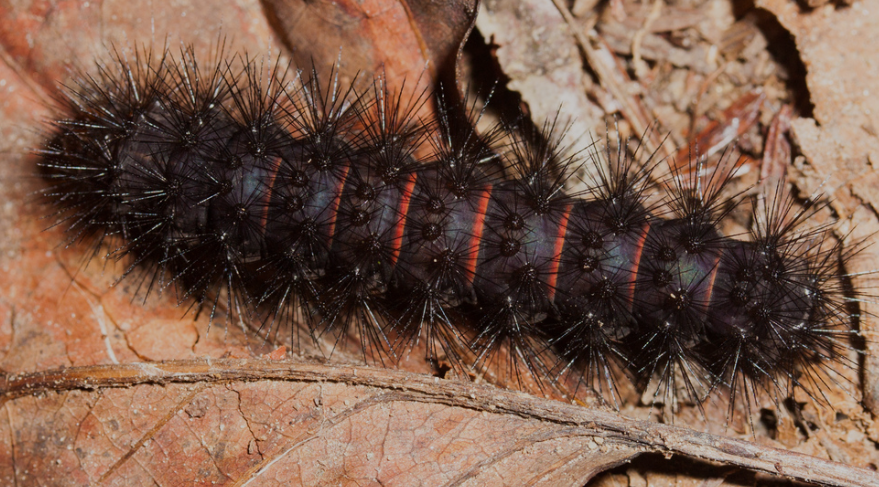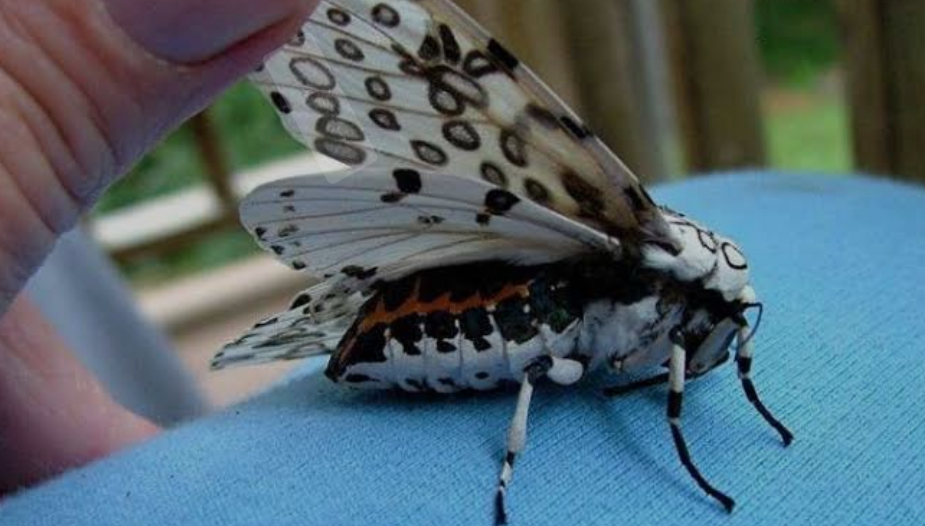
Classification
The Giant Leopard Moth Caterpillar belongs to the family Erebidae, a diverse group of moths that includes tiger moths, lichen moths, and other colorful species. Its scientific name is Hypercompe scribonia. Like other members of the family, it undergoes complete metamorphosis, progressing from egg to larva (caterpillar), pupa, and finally to adult moth. This family is characterized by often strikingly patterned adults and hairy or spiny larvae, which the Giant Leopard Moth exemplifies.
Identifying Characteristics
The caterpillar of the Giant Leopard Moth is immediately recognizable due to its thick, black, bristly body covered with long, dense setae (hairs). When threatened, it often curls into a spiral, revealing bright red-orange underbands along the sides of its segments, creating a striking warning display.
The adult moth is equally distinctive, with large white wings adorned with numerous black spots, resembling a leopard’s coat, and a robust white body with additional black markings. The dramatic contrast in coloration helps deter predators in both life stages.
Distribution, Migration & Habitat
The Giant Leopard Moth is native to the eastern and southeastern United States but has been reported as far west as parts of Texas and Oklahoma. It is a non-migratory species, remaining within its established regional range throughout its life.
Its preferred habitats include woodlands, gardens, fields, and suburban areas, particularly locations with abundant host plants for the caterpillars. Adults are nocturnal and are often attracted to lights at night, making them a familiar sight around homes and street lamps.
Predators & Threats
The caterpillar’s spiny body and bright warning colors provide protection against many predators, though birds, predatory insects, and small mammals may still pose a threat. Parasitic wasps and flies can also attack larvae by laying eggs on or inside them.
Adult moths rely on camouflage and nocturnal activity for defense, avoiding diurnal predators. Habitat loss, pesticide exposure, and artificial lighting are additional human-related threats that can reduce local populations.
Lifespan of Adults
Adult Giant Leopard Moths have a relatively short lifespan, usually living only about one to two weeks. Like many other members of the Erebidae family, adults do not feed, lacking functional mouthparts. Their primary purpose is reproduction. Males seek out females using pheromones, and after mating, females lay clusters of eggs on suitable host plants. After reproduction, adults quickly die, completing the species’ life cycle.
Host Plants & Diet
Giant Leopard Moth caterpillars are polyphagous, feeding on a wide variety of plants. Their diet includes dandelions, violets, plantains, sunflowers, and other low-growing vegetation. This broad diet allows them to thrive in diverse habitats, from forest edges to suburban gardens.
The larvae are voracious feeders, consuming leaves throughout their development until they are ready to pupate. The adult moth, as noted, does not eat and relies entirely on stored energy from the larval stage.
Life Cycle of Giant Leopard Moth Caterpillar (Hypercompe scribonia)

Egg Stage
The life cycle of the Giant Leopard Moth begins when females lay small clusters of eggs on the underside of leaves of suitable host plants. Each cluster may contain 10 to 30 eggs, which are pale green to yellowish in color.
These eggs are tiny and round, and their placement on the underside of leaves helps protect them from direct sunlight and many predators. The incubation period lasts approximately one to two weeks, depending on temperature and environmental conditions, after which the larvae hatch.
Larval Stage (Caterpillar)
Upon hatching, the larvae are small and initially less conspicuous, with short, soft hairs. As they grow through successive instars, they develop their characteristic thick black bristles and red-orange bands along the sides of their segments. The bright coloration serves as a warning to predators, signaling their potential toxicity or unpalatability.
The caterpillars are voracious feeders, consuming a wide range of host plants including dandelions, violets, plantains, and sunflowers. This stage can last several weeks to a couple of months, depending on environmental conditions, during which the caterpillar molts multiple times, shedding its exoskeleton to accommodate its growing body.
Pupal Stage (Cocoon)
When fully grown, the Giant Leopard Moth caterpillar spins a loose silk cocoon, often incorporating leaves or other debris for camouflage. Inside the cocoon, it transitions into the pupal stage, a period of dramatic transformation called metamorphosis.
During this time, the caterpillar’s body is broken down and reorganized into the adult moth form. The pupal stage may last a few weeks during warm seasons, but in colder regions, the pupa can overwinter, delaying emergence until the following spring.
Adult Stage (Moth)
The adult Giant Leopard Moth emerges from the cocoon with striking white wings covered in black spots, reminiscent of a leopard’s pattern, and a stout body marked with additional black spots. Adults are nocturnal and do not feed, relying entirely on energy stored during the larval stage.
Their short lifespan, usually one to two weeks, is devoted exclusively to mating and reproduction. Males use pheromonal cues to locate females, after which the female lays eggs on host plants to begin the next generation. After completing reproduction, the adults die, completing the species’ life cycle.